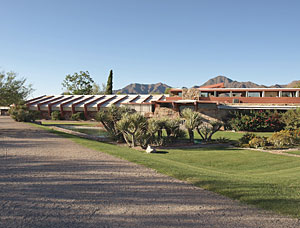The Frank Lloyd Wright School of Architecture, also known as Taliesin, regained full accreditation last month from the Higher Learning Commission (HLC). Its future had been in doubt since the HLC placed it on notice in 2005, following falling enrollment and turmoil within the Frank Lloyd Wright Foundation, which runs the school. Maintaining HLC accreditation is a prerequisite for National Architectural Accrediting Board accreditation, which the school currently has for its master's program.

Taliesin West, in Scottsdale, Arizona, is one of two campuses for the Frank Lloyd Wright School of Architecture.
“The stakes were very high for accreditation,” observes Victor Sidy, AIA, who was appointed as the new dean two years ago. “We’ve since streamlined administration and empowered our fulltime faculty to take a more active role in development.”
Taliesin today has 19 students and four fulltime faculty members. Although that’s double the size it was two years ago, it is still one of the country’s smallest accredited architectural schools, with a $500,000 annual budget. Taliesin also remains unusual for its pedagogy. Students follow Wright’s credo that architects should “learn by doing.” The school will continue to emphasize this and other core values including sustainability, Sidy says, but it is encouraging students to explore a broader, more diverse spectrum of architectural styles and periods, using Wright as a touchstone rather than a doctrine.
“We’re now stretching out, encouraging students to develop their own voice,” Sidy explains. “If we still retain Wright’s legacy, it’s through innovation and examining the nature of a thing.”
Taliesin’s re-accreditation with HLC marks a bright spot for the otherwise beleaguered Wright foundation, which has suffered financial woes, management turnover, and board turmoil during recent years. The cash-strapped organization needs more than $100 million to repair and restore its two crumbling Taliesin campuses. The school spends half the year in Scottsdale, Arizona, and the other half at Wright’s former house in Spring Green, Wisconsin, which the National Trust for Historic Preservation added to its “11 Most Endangered Places” list in 1994.
Maintenance on the Taliesin properties, which attract roughly 150,000 visitors annually, costs roughly $1.5 million a year. The foundation recently held a “mini Continental Congress” to revamp its bylaws, provisions, and organizational structure to attract more philanthropy dollars, says Phil Allsopp, RIBA, foundation president and CEO. Among the changes: the Taliesin Fellowship, a group of longtime Wright disciples, forfeited veto rights on the foundation board. “We are now operating with a single voice,” Allsopp says. “We made our corporate governance a lot cleaner, which is important to the philanthropic community.”
The foundation hopes to raise $200 million over the next 10 years to renovate and preserve its Taliesin campuses. Additionally, it’s seeking to hire a fulltime maintenance professional to direct and oversee conservation duties. “These are fragile structures built with a lot of experimentation,” Allsopp observes. “We want to make sure the buildings, school and legacy are available for future generations.”

Post a comment to this article
Report Abusive Comment